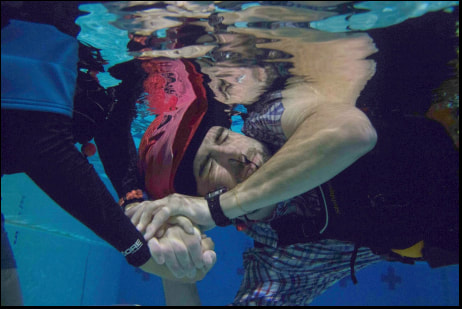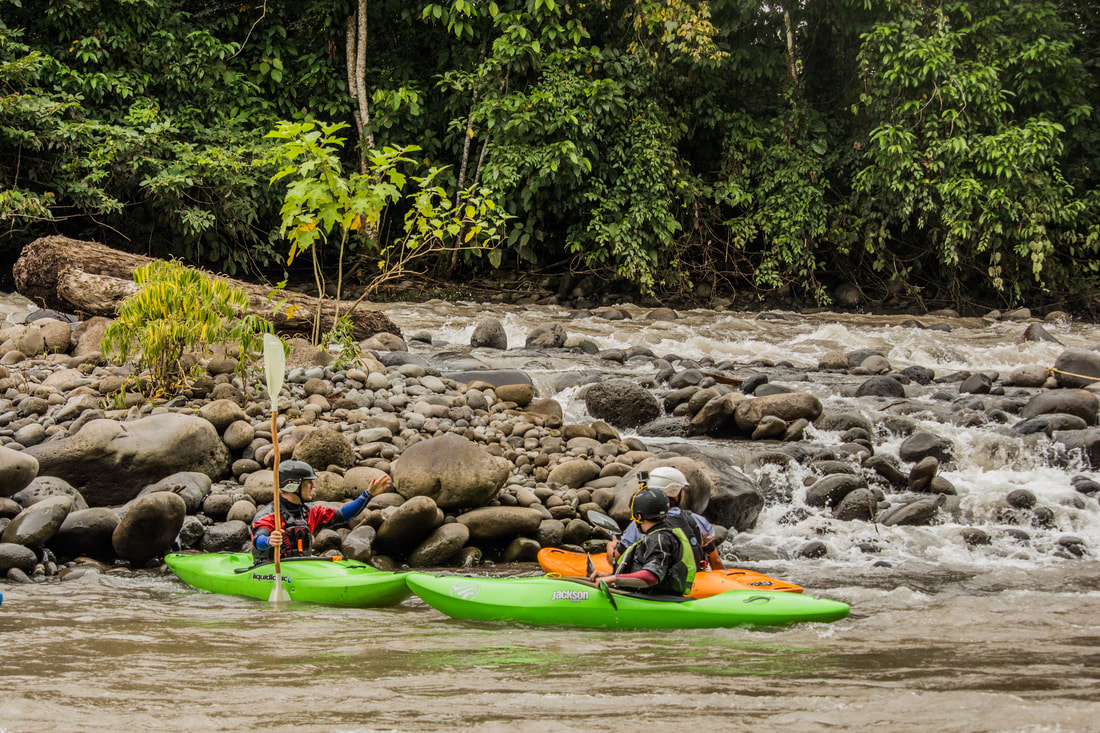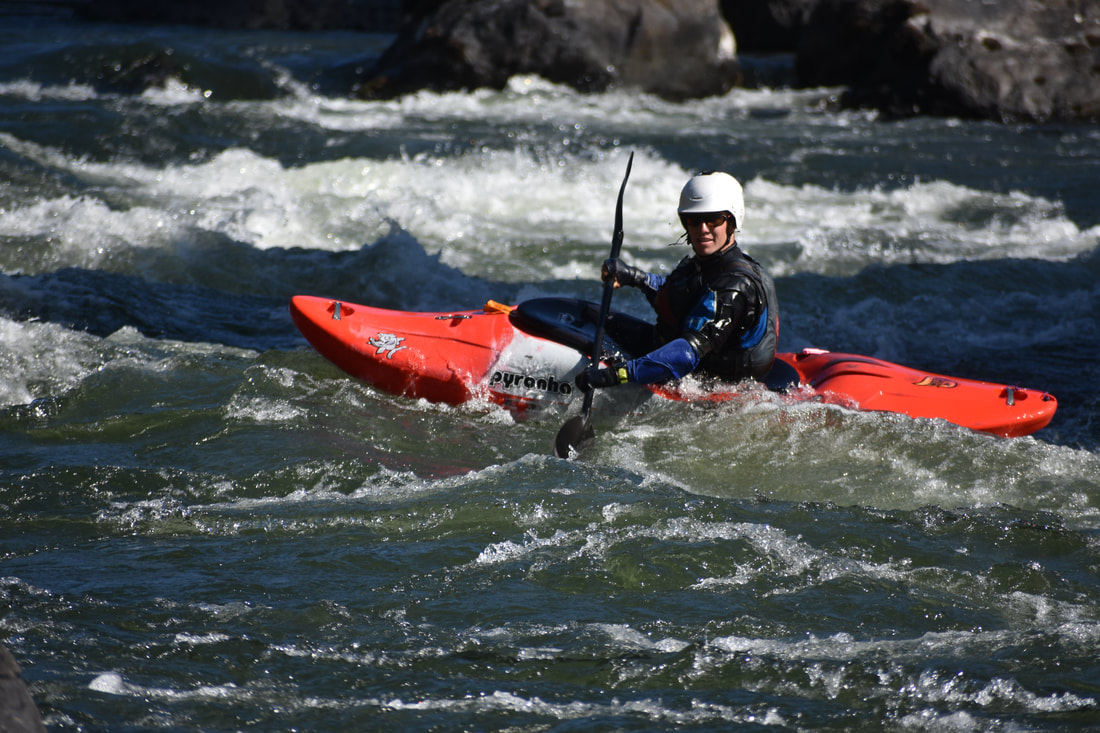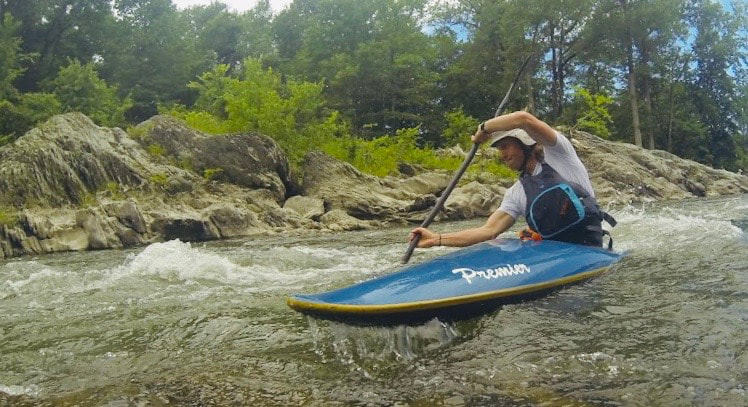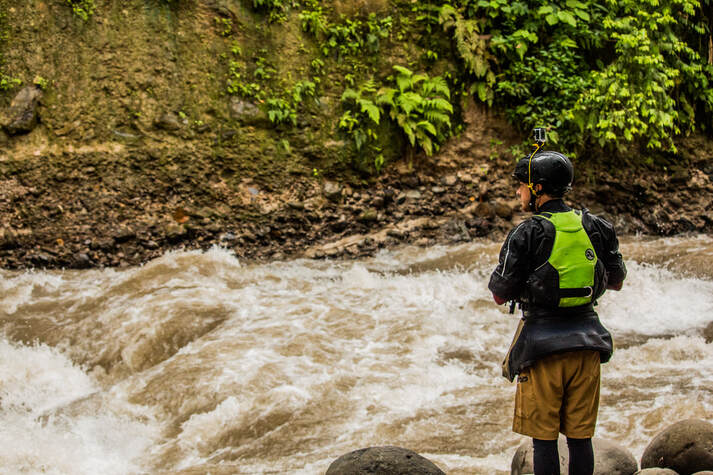Underwater composure is how calm someone can be underwater in a variety of positions and conditions. I cannot stress enough the importance of developing composure underwater before beginning the process of learning how to roll. I’ve seen it time and time again where someone is rushed through a rolling progression by a friend (or sometimes an instructor) and after hitting a few successful rolls their friend gives them some space or tells them they’re “good to go”. After paddling around for a bit the new kayaker flips over, misses their first roll, their instincts take over their mind, they pull with all their might on the paddle, their head comes up, and they do a frantic wet exit. A situation like this can do a number on a new kayaker’s confidence and imprint a negative memory about flipping and trying to roll. Below I’ve outlined some “underwater composure” exercises that I’ve done with countless students over the years including a fair number of students with hyper-anxiety about being upside in a kayak. This is an array of exercises that I pick and choose from to help assess and/or develop underwater composure. I usually jump straight into these activities after we carry our kayaks over to the water’s edge and before I jump into the steps of a “wet exit”. Exercises and Experiments: Part 1 1) “Get in and float”: This is an opportunity to just float in the water and feel the life jacket float you and how it floats you. It’s also an opportunity to make any adjustments on gear that may have become loose in the water. After floating for a bit try putting your face down in the water and feel the water surround your face and ears (blow some bubbles under there if you want).. Then make sure you try to swim around too (freestyle and side stroke), it’s a bit different with all that gear on. 2)“Somersaults anyone?”: If you’re up to it, doing forward and reverse somersaults in the water can be a great experience to really feel the water in somewhat of a disorienting movement. During this experience you are bound to get water in your nose if you aren’t wearing nose clips, and that's a good thing. If you don’t have nose clips you might as well begin getting used to a little water in the nose. This experience will either encourage you to purchase a pair of nose clips or help you realize that you don’t need any. **Note, if somersaults aren’t your thing try some “log rolls” in the water. Again, we’re just going through somewhat disorienting movements in the water and focusing on feeling the water around us. Now take a few minutes to dry off and then hop in that kayak and practice some “dry land wet exits” until you feel like you’ve got the steps dialed. When you’re ready slide into the water and connect with whomever you’re working with (ideally a trained/certified instructor) and let them know you’re ready to practice some wet exits. You should practice wet exits a lot! This is a tremendously valuable skill and is your first self rescue option. You don’t have to rely on anyone else when you do a wet exit and that is extremely empowering. After practicing a lot of wet exits hop back into your kayak and slide back out into the water with the instructor (or friend you’ve been working with) for some more kayak specific underwater composure exercises! 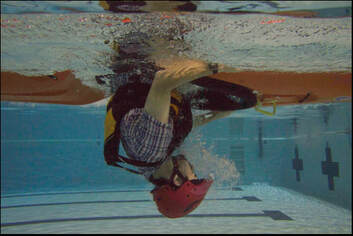 Exercises and Experiments: Part 2 1)“Get barrel rolled”: With the instructor or friend standing next to you, flip over, get into a tucked position, and tap on the sides of the kayak, this is you asking for a rescue. Stay in this tucked position and tapping on the sides of the kayak until the instructor barrel rolls you up, also known as the “hand of God rescue”. Once you’ve done this a couple times start going underwater and holding your breath longer before asking for a rescue (tapping on the sides of the kayak). 2)“Underwater Observations”: Now that we’ve established a technique for you to stay in the kayak and to ask for rescue when you’re ready to come up, let’s move onto some more thought provoking exercises. Now when you go underwater pay attention to the temperature of the water and only the temperature (we’re isolating senses here). Feel the temperature of the water on your cheeks, your eye lids, inside your ears, etc. After a few seconds tap on the kayak for a rescue, once you're up articulate what you felt to your instructor or friend. If we can get our mind to focus on other things when we’re underwater we’ll be less apt to become anxious about getting right side up. 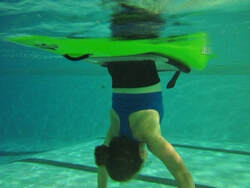 3)“You want me to do what?”: Now that you’re really developing your mental underwater composure let’s try some physical challenges. While upside down try to perform a “circular motion” with your entire torso; tuck forward with your chest and face as close to the spray skirt as possible, then begin moving clockwise, your right oblique should be pushing into the side of the cockpit, keep moving clockwise, your back and head should be arched towards the back deck, keep moving clockwise, your left oblique should be pushing into the left side of the cockpit, keep moving clockwise, and now you should be back into a “tucked position” and can tap for a rescue. This circular motion should be performed slowly and deliberately with focus and attention on how the body feels in each position. You can obviously perform this same exercise going counter clockwise as well (and you should). This exercise increases comfort under water and also develops a kayaker’s composure moving in and out of different physical positions while upside down in their kayak. Additionally, having an increased awareness of your body’s position as it relates to the kayak while being under water can greatly improve your understanding of the kayak roll. You can very easily put yourself at risk of developing a physical injury or a psychological barrier if you don’t spend adequate time developing underwater composure before progressing into other kayak skills. The composure practice doesn't end even once you’ve developed basic underwater composure, learn a “bow assisted rescue”, and even the kayak roll. With increased knowledge and skills you will have more tools to continue increasing your comfort underwater in a variety of conditions. Underwater composure is a trained and practiced skill that we should all revisit often in our paddling. For more water composure activities check out this short video: "Pool Session"
0 Comments
Most of us have experienced a time when a member of our paddling crew says, “there’s ____ (x amount) of scouts on this section”, or, “I’m going to scout the next rapid.” I want to be clear, I have no problem with scouting, I absolutely encourage it. My issue is that most of us perceive scouting to mean one thing, getting out of our kayaks, walking on shore, and ‘land scouting’. I’d argue that for most of us this is what we picture when we use the term ‘scouting’. It can, and should bring to mind, much more. To best unpack my issue of this singular mindset, it’s worth defining scouting in its most basic form. I believe that scouting at its foundation is the gathering of information in order to make an informed decision. If we can agree (at least for the sake of discussion) on that definition then we should be open to the idea that there are numerous types/methods of scouting (these may be novel ideas for some and revisiting frequent practices for others). Some of these methods of scouting include: Scouting Remotely: Using guidebooks, local knowledge, online resources, etc. to gather information about a river section or specific rapid(s). By using the information that’s accessible to us we’re able to make thoughtful decisions regarding whether or not we should pursue paddling a particular section of river. This could include: level of difficulty, recommended water levels, old/new hazards, access points, etc.
In order to make thoughtful and informed decisions we need to be able to effectively see the features that we may encounter. If we’re unable to process everything in front of us due to our speed or the quantity, size, or complexity of the features we need to slow the decision making process down by employing one of these scouting strategies. To recap, we need to select an alternative method of scouting that matches the environment if we can’t see what we need to, a rapid or line looks overly complex, or we’re simply moving too fast.
Scouting allows us to be more deliberate and mindful in our paddling. By using thoughtful scouting practices to clearly identify and select a ‘line’ before proceeding through a rapid we are able to more objectively assess our performance. The objective is sharing these thoughts is to encourage paddlers to broaden our perceptions of ‘scouting’, and to do it constantly. Rhetorical questions/comments below are aimed at initiating thoughts and reflection.
Paddling: Identifying whether one's performance of a skill/maneuver was effective is usually straightforward; was the desired outcome met, yes or no? Once one has identified how to effectively perform the skill or maneuver, it's in my opinion worth spending time focusing on efficiency. How do you define "efficient" paddling? What does "efficient" look like? What does it sound like? What does it feel like? Once you've felt "efficiency", can you chase that feeling to repeat it? How do you define efficiency in regard to specific skills and maneuvers? Answering these questions will undoubtedly help in developing/fine tuning one's mental model of the skills and maneuvers that we use while paddling. Instruction, Teaching, and Coaching: Now consider taking the content and points from above and change your perspective and focus from your own paddling to the role of a paddling instructor or coach. As paddlesport instructors, in order to truly make sense of a performance and be able to offer meaningful feedback (among other things), we should have clear mental models for what goes into that skill or maneuver. Getting into the "weeds" and unpacking what goes into a particular skill or maneuver can be daunting (or at least it can be for me). For this reason having some sort of a framework to assist in this process can be very helpful. Some years ago Todd Johnstone-Wright introduced the "T. T. P. P. E. E." model to me as a tool for understanding the "demands" of a skill or maneuver. This tool has assisted me in planning, observation and analysis, formulating feedback, etc. T. T. P. P. E. E: Tactical - Technical - Physical - Psychological - Environment - Equipment While I believe that having clarity around your own mental models is an essential part of being an effective instructor or coach, these mental models should also be informed by science. As my friend and colleague, Chris Wing, has said (paraphrasing), "people should be able to convey biomechanics in their own words, but it has to embrace the underlying framework of science." In essence, it's my view that we can have our own opinions, but in order to be informed and accurate, they should be based on the biomechanics and physics of our sport. Hope this info finds folks well, and that at the very least it prompts a bit of reflection. Happy paddling. Knowledge + thoughtful experience with reflection = understanding. Understanding will assist paddlers in anticipating and predicting the effects different river features will have on them. This will inform their scouting, choice of lines, and planning (decision making). Take time to learn about different river features, but also work to experience and feel these features as well. Here are a few points to consider when you’re looking to experience/experiment with river features: -Paddle with a patient, supportive, and experienced group. -Consider the “what if’s” (what if the feature flips me over, what if I get stuck in the feature, what's immediately downstream of the feature, etc.). -Aim to develop these experiences in as controlled an environment as possible (remember we’re focused on learning not simply surviving). -A quality instructor or coach can support this learning process through sharing or initiating/prompting meaningful feedback (extrinsic or intrinsic). **While likely obvious, we don’t need to directly experience/feel river hazards (undercut rocks, sieves, strainers, etc.) to know that we should do everything possible to avoid them (including portaging). Additional perspectives from close friends and colleagues: (paraphrasing) Mary and Phil DeRiemer: “Instead of thinking of them as river obstacles, why don’t we consider them as opportunities. They can be opportunities to use our skills to avoid, or opportunities to work with and use the river feature.” Nate Ostis: “Don't underestimate the powerful learning that comes from deliberate swimming and wading in rapids, using different features to assist our movement throughout the river." Once we understand the effects different river features will have on us, we can more accurately assess/scout rapids and make informed decisions. Lastly and worth noting, "understanding" can and will very likely increase our confidence on the river, or in the words of my friend and colleague, Jess Matheson, “we can increase confidence through competence”. Happy paddling. |
